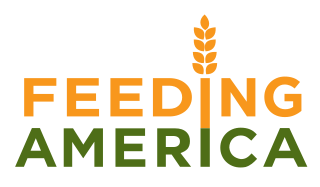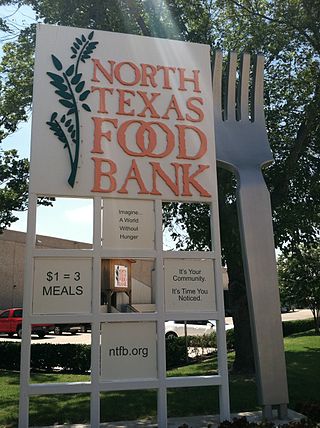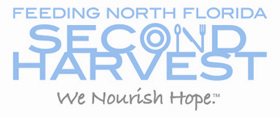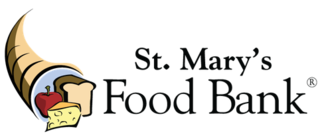
A soup kitchen, food kitchen, or meal center is a place where food is offered to the hungry usually for free or sometimes at a below-market price. Frequently located in lower-income neighborhoods, soup kitchens are often staffed by volunteer organizations, such as church or community groups. Soup kitchens sometimes obtain food from a food bank for free or at a low price, because they are considered a charity, which makes it easier for them to feed the many people who require their services.

Meals on Wheels is a program that delivers meals to individuals at home who are unable to purchase or prepare their own meals. The name is often used generically to refer to home-delivered meals programs, not all of which are actually named "Meals on Wheels". Many of the housebound recipients are the elderly, and many of the volunteers are also elderly but able-bodied and able to drive automobiles.

Feeding America is a United States–based non-profit organization that is a nationwide network of more than 200 food banks that feed more than 46 million people through food pantries, soup kitchens, shelters, and other community-based agencies. Forbes ranks it as the largest U.S. charity by revenue. Feeding America was known as America's Second Harvest until August 31, 2008.

The North Texas Food Bank (NTFB) is a social benefit organization located in Plano, Texas. The organization distributes donated, purchased and prepared foods through a network of nearly 1,000 feeding programs and 400 Partner Agencies in 13 North Texas counties. The NTFB supports the nutritional needs of children, seniors, and families through education, advocacy and strategic partnerships.
The Arkansas Foodbank is a non-profit food bank located in Little Rock, Arkansas. The Arkansas Foodbank distributed more than 20.9 million pounds of food and grocery products to its member agencies for Arkansans in need in 2013, according to chief executive officer, Rhonda Sanders.

The Houston Food Bank (HFB) is a non-profit organization and the nation's largest food bank by distribution; providing access to 207 million nutritious meals in 18 counties in southeast Texas. The food bank's operations are made possible through a network of 1,800 community partners alongside their partner food banks in Montgomery County, Galveston and Brazos Valley. Headed by its current President and CEO, Brian Greene, the Houston Food Bank is a member organization of Feeding America, with a four-star rating from Charity Navigator. The Houston Food Bank, which bares the mission statement of Food for Better Lives, continues to be acknowledged for its community impact. Notable recognitions include Food bank of the Year in 2015, presented by Feeding America and the Pinnacle winner in 2012 and 2014, presented by the Better Business Bureau.

Food rescue, also called food recovery, food salvage or surplus food redistribution, is the practice of gleaning edible food that would otherwise go to waste from places such as farms, produce markets, grocery stores, restaurants, or dining facilities and distributing it to local emergency food programs.

Redwood Empire Food Bank (REFB) is a food bank on the North Coast of California which belongs to the Feeding America network. Its mission is to end hunger in its community.
Food Bank For New York City is a non-profit social services organization and the major hunger-relief organization working against hunger in the five boroughs. Its aim is to organize food, information and support for needy citizens of New York City.

Leket Israel, The National Food Bank, a registered nonprofit Israel-based charity, is the leading food rescue organization in Israel, serving 175,000+ needy people weekly. Leket Israel rescues surplus agricultural produce and collects excess cooked meals for redistribution to the needy throughout Israel via its network of 200+ nonprofit organization (NPO) partners.
Hunger Task Force, Inc. is a non-profit, anti-hunger public policy organization in Milwaukee, Wisconsin. Hunger Task Force works to end hunger in Milwaukee County, Wisconsin by providing direct food delivery services, and works to end future hunger by advocating for fair and responsible administration of federal nutrition assistance programs.
Philabundance is a non-profit food bank that serves the Philadelphia and Delaware Valley regions of Pennsylvania, United States. It is the largest such organization in the region. The organization stated goal is to end hunger in its communities.
The Alameda County Community Food Bank is a non-profit organization that supplies food to 275 Alameda County, California agencies including food pantries, soup kitchens, child-care and senior centers, and after-school programs, provides an emergency food helpline, teaches nutrition and hunger education, and conducts outreach about California's food stamps program CalFresh. Located in Oakland, California, the food bank distributes enough food for 300,000 meals weekly. Almost 50% of the food supply consists of fresh produce from California farms. The organization is a member of the California Association of Food Banks, Feeding America, and the California Hunger Action Coalition. Their headquarters are at 7900 Edgewater Drive, next door to Oikos University. The food bank is in the former location of the book distributor Bookpeople.

Hunger in the United States of America affects millions of Americans, including some who are middle class, or who are in households where all adults are in work. The United States produces far more food than it needs for domestic consumption—hunger within the U.S. is caused by some Americans having insufficient money to buy food for themselves or their families. Additional causes of hunger and food insecurity include neighborhood deprivation and agricultural policy. Hunger is addressed by a mix of public and private food aid provision. Public interventions include changes to agricultural policy, the construction of supermarkets in underserved neighborhoods, investment in transportation infrastructure, and the development of community gardens. Private aid is provided by food pantries, soup kitchens, food banks, and food rescue organizations.

Second Harvest North Florida (SHNF) is a 501(c)(3) non-profit organization located in Jacksonville, Florida, that performs food rescue and redistribution to partner agencies in one quarter of Florida's 67 counties. The charitable organization has been active for over 30 years.

A community fridge is a refrigerator located in a public space. Sometimes called freedges, they are a type of mutual aid project that enables food to be shared within a community. Some community fridges also have an associated area for non-perishable food. Unlike traditional food pantries, these grassroots projects encourage anyone to put food in and take food out without limit, helping to remove the stigma from its use. The fridges take a decentralized approach, often being maintained by a network of volunteers, community members, local businesses, and larger organizations. Food in community fridges is primarily donated by individuals or food rescue organizations and can be sourced from a variety of places. Major grocers like Trader Joe's and Whole Foods donate large amounts of excess foods to food rescue organizations that then donate to these fridges. The food donated would have otherwise been thrown out.
Northern Illinois Food Bank is a 501(c)(3) non-profit organization that focuses on providing food to those in need in northern Illinois. Partnerships and donors allow for more than 71,000 people to be fed each week through different programs. Northern Illinois Food Bank operates in 13 counties surrounding Chicago. The organization has four distribution centers located in Geneva, Rockford, Park City, and Joliet, which distribute food to pantries who then allocate the food to people.

La Soupe is a Cincinnati, Ohio, nonprofit organization that uses discarded food to produce meals and delivers them to other nonprofit agencies for distribution to people experiencing food insecurity.

St. Mary's Food Bank Alliance is a nonprofit, nonsectarian organization located in Phoenix, Arizona. Founded in 1967 by John van Hengel, St. Mary's was the first modern organization to operate using the food bank model, which spread throughout U.S. and the rest of the world. Today, St. Mary's is recognized as the world's first food bank.

Rethink Food NYC Inc, commonly called Rethink Food or just Rethink, is a non-profit organization based in New York City. The organization was founded to address hunger in the United States by contributing to a sustainable and equitable food system. Rethink collects excess food from restaurants, grocery stores, and corporate kitchens to provide nutritious meals for people living without food security at low or no-cost. The organization expanded its operations in March 2020 to meet growing food demands amid the COVID-19 pandemic in the United States.



















